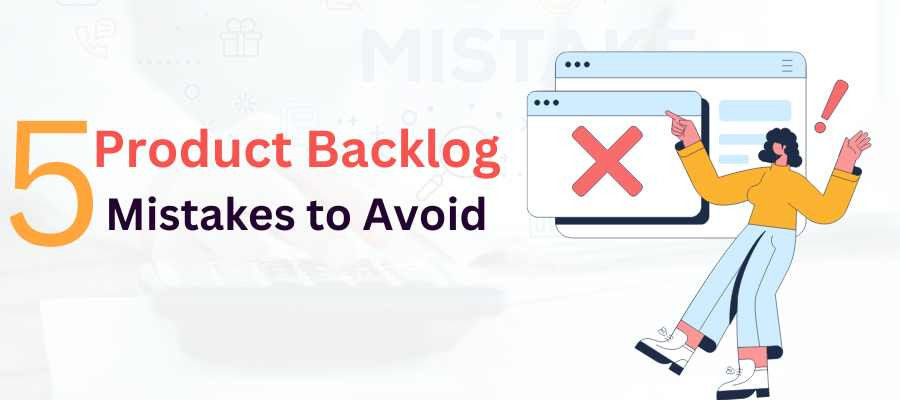5 Product Backlog Mistakes to Avoid

Product Backlog is a powerful tool that helps the Scrum Master to capture and change complex product decisions based on capacity availability. The Product Owner is also accountable for refining the Backlog Items and assigning tasks to the Developers. Unfortunately, the backlog refinement procedure can be as complex as challenging for the Product Owner!
This article discusses five common Product Backlog handling mistakes with detailed resolution ideas to fix them. So let’s focus on the Features, Functions, Fixes, Requirements, and Enhancements of the Product Backlog from now on!
1. Too Big Product Backlog Without A Proper Product Roadmap
A Product Roadmap is a strategic plan for executing the Product Vision within a dedicated timeline. It directs the Developers and Testing team on how to carry out upcoming development activities. If the Product Roadmap is not well-defined, the Product Backlog becomes too big for the operational teams to handle.
Mistakes:
- The Agile teams start working on the Backlog Items with a Release Plan instead of the Roadmap.
- The Product Backlog Item (PBI) doesn’t connect to the unique Product Vision.
- Too many Backlog Items make it harder to do Sprint Planning.
Solution:
Develop the Product Strategy with a well-defined Product Roadmap for the Scrum Team, Developers, and Testers to follow. The Product Owner should explain his Product Vision to the teams. The journey to develop the ultimate product requires many checkpoints following the Product Roadmap.
2. Poor Product Backlog Management
Product Backlog Management takes care of all product requirements that the Developers need. If not done right, it affects the Product Goal for the coming Sprints.
Mistakes:
- Too detailed User Stories reduce the development effort at the initial level.
- The Product Vision changed based on feedback from customers and stakeholders.
- Completely transparent Product Backlog management by the Scrum Team.
- Accept all stakeholder inputs and make the Product Backlog more extensive.
Backlogs should not become prominent with a few details for the Developers to handle. It might lead to a weak product value proposition with poor user experience. Also, it becomes difficult for the Scrum Team to update and manage such long backlogs.
Solution:
- Let the Developers decide “what” and “how” they plan the Sprint Goal based on the Product Backlog Item (PBI).
- Conduct a Sprint Planning meeting engaging every Agile Practitioner to set a transparent product development direction.
- Include step-by-step action plans for every User Story with minimal input details for the Developers.
3. Lack Of Appropriate Backlog Refinement
Most Agile teams need help to commit to the Sprint Goal 100%. In case of over-commitment, the teams need to do appropriate backlog refinement in the next Sprint Planning.
Mistakes:
- The Certified Scrum Master fails to maintain all tasks under the Product Backlog Item (PBI).
- The Product Owner needs to prioritise the active User Stories efficiently.
- The Scrum Team’s Backlog Management does not ensure high fidelity.
Solution:
Appropriate Backlog Refinement is a must for the Certified Scrum Product Owner. It is the only way to commit all stakeholders to the expected Product Goal. Here are a few tips for consistent Backlog Refinement:
- All Work Items are clear and well-explained, with no open questions from the Developers.
- The Scrum Master estimates the team capacity and then assigns tasks to the team.
- The requirements based on the User Stories can be completed within one Sprint.
- Treat the Product Backlog Items as units to add value to the Product Vision.
4. Product Backlog Is Not Well-Prioritized
The key to managing Product Backlogs is to create smaller User Stories after considering customer feedback. The Product Owner’s responsibility is to prioritise the active User Stories based on the Product Backlog.
Mistakes:
- Only the Product Owner is accountable for maintaining and prioritising the User Stories.
- User stories are split horizontally, which doesn’t add much value based on the end Product Goal.
- Working on all features may result in hundreds of User Stories with multiple releases.
Solution:
- Split the User Stories based on the developers’ perspectives and pre-planned Product Strategy.
- Use the vertical User Story splitting strategy to divide tasks among Developers.
- The Product Owner must prioritise the feature set based on the related PBIs.
5. Product Backlog is Only The Product Owner’s Responsibility
If the Product Owner is solely responsible for Product Backlog refinement, it becomes difficult for him to write all User Stories and distribute high-priority work items to Developers. It leads to the following mistakes:
- The teams fail to work collaboratively on the User Stories.
- The development teams don’t get involved in the Backlog refinement, failing to understand the Sprint Goal.
Solution:
- Product Owners should conduct collaborative Product Backlog refinement meetings.
- Create co-managed work items for the Developers and Testing Teams to work.
- Participate in Sprint Planning to understand the Sprint Goal.
Key Takeaway:
As an Agile Practitioner, you must clearly know how to handle Product Backlog Items. The mistakes mentioned earlier are commonly seen in today’s Agile project management approach. Work on the given solutions to improve team collaboration toward achieving the end Product Goal.
Reference
- https://www.linkedin.com/pulse/seven-product-backlog-mistakes-avoid-roman-pichler/



